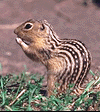Watchable Wildlife in Utah

The Watchable Wildlife Program
Where to go
Viewing Hints
Outdoor Ethics
Recent Watachable Wildlife Events
This Article originally from
http://www.wildlife.utah.gov
THE WATCHABLE WILDLIFE PROGRAM
Historically, wildlife management in Utah has largely focused
on hunted species. Sportsmen, through license fees and federal
taxation on firearms and fishing tackle, have carried the burden
of funding state wildlife programs in the past and this remains
largely the case today. Often, these programs have benefited
non-hunted species of wildlife through habitat enhancement and
preservation. Direct management for appreciative uses has been
a low-key effort by comparison.
Recently, public interest in wildlife-oriented activities
such as photography and viewing have taken a dramatic upturn.
In response to this situation, federal and state land and wildlife
management agencies in Utah have formed a partnership with conservation
organizations. This effort, known as the Watchable Wildlife
Program, provides Utah's citizens and visitors alike a new opportunity
to enjoy and better appreciate one of its greatest heritages-its
wildlife. The Utah Wildlife Viewing Guide is the first step
in this effort and will serve as the focal point for a complete
Watchable Wildlife Program in the years to come. This publication
may be purchased through the DWR publications department. The
next step, enhancement of individual viewing sites, is just
getting under way in the state. Site enhancement involves such
things as interpretive signing, trail development, construction
of viewing blinds or platforms, and provision of parking and
restroom facilities.
An additional benefit of the Watchable Wildlife Program is
to expand our understanding of the world around us. It can help
us to better value diversity or to see the value of all components
of our natural environment. Species that are neither hunted,
viewed, nor photographed may play a critical role in the health
of another species, or indeed, an entire ecosystem. By viewing
wildlife in its natural habitat, perhaps we may better appreciate
the importance of all elements of the biological and physical
world around us.
WHERE TO GO
Additional wildlife viewing opportunities may be found on
the bird
sightings,
wildlife events and festivals and
accessibility
for disabled persons pages.
 VIEWING
HINTS VIEWING
HINTS
- The first and last hours of daylight are generally the
best times to view or photograph most species. Seasonally,
spring and early summer are the best times to view many
species such as songbirds, small mammals, and hoofed mammals
since they are most active throughout the day during this
period.
- Be quiet. Quick movements and loud noises will normally
scare wildlife. Since your car or boat is a good viewing
blind, you may actually see more by remaining in the vehicle.
Streams should be approached slowly and vegetation used
as a screen to avoid scaring fish in shallow water. Notice
how much more often you see animals when you are still than
when you are moving. Whisper when you speak.
- Use as many viewing aids as possible. Binoculars or
spotting scopes are always desirable to enhance your observations.
Field guides are helpful with identification and other pertinent
facts. Polarized glasses help reduce glare and make fish
viewing easier.
- Be patient. Wait quietly for animals to enter or return
to an area. Give yourself enough time to allow animals to
move within your view. Patience is usually rewarded with
a more complete wildlife experience.
OUTDOOR ETHICS
- Honor the rights of private landowners. Gain permission
of private landowners before entering their property.
- Honor wildlife's requirement of free movement. Feeding,
touching, or otherwise harassing wildlife is inappropriate.
Young wild animals that appear to be alone have not been
abandoned; allow them to find their own way.
- Honor the rights of others to enjoy their viewing experience.
Loud noises, quick movements, or extraordinary behavior
that might scare wildlife is inappropriate. Wait your turn
or seek another viewing opportunity.
- Honor your own right to enjoy the outdoors in the future.
Leave wildlife habitat in better condition than you found
it. Pick up litter that you might encounter at a viewing
site and dispose of it properly.
We would like to thank the Utah Division of Wild Life Resources
for allowing us to use content from their website and would
encourage you to visit them at
http://www.wildlife.utah.gov
for more information on Utah's vast wildlife resources.
|